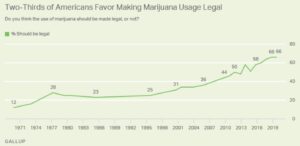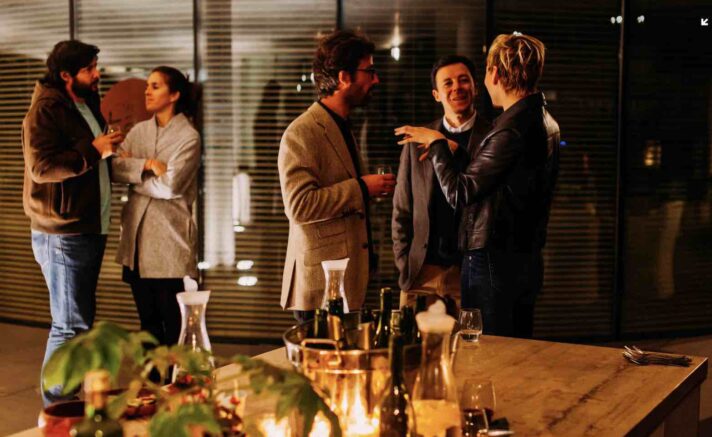“When will our table be ready?” I asked.
“We’re waiting for a party to finish up. It shouldn’t take more than another thirty minutes,” the hostess replied.
I looked at her surprised, “Thirty minutes more minutes? Our reservations were for half an hour ago. That’ll mean we’ve been waiting for an hour to get our table. Is there any way you can seat us now, we’re starving!”
“I’m sorry sir,” she replied, “We’re at maximum capacity and we don’t have any available tables for a party of your size. I’ll make sure to have the manager comp your drink tab while you wait in the bar area.”
We were on the 60th floor in downtown Manhattan, just two blocks away from the World Trade Center, and had just finished up a long day at a cannabis conference. Anyone who has been to a conference, regardless of the industry, knows that the real business happens at night.

That’s a picture from the actual restaurant we were at, ‘Manhatta’.
The conference during the day is just a chance to catch up with old acquaintances and show your face to everyone in the industry to let them know you still exist. Nothing ever gets accomplished during the day, except for awkward small talk and mostly-worthless business card exchanges.
I had invited eight people to dinner, which unfortunately seemed to be too many for this particular restaurant. While we waited in the bar area, my invitees got to know each other, as none of them had ever met before – something that I had intentionally set up.
The group included myself, three cannabis investors (private individuals), an investment banker, a venture capital fund manager (tech), a branding executive (fashion), and a researcher from a major psychedelic non-profit organization.
I specifically gathered this group of people together because everyone has a similar interest in the emerging cannabis and psychedelics industries. Each person brought a different perspective and background, which I thought would make for interesting conversation.
As we waited in the bar area of the restaurant, we stood around a high top round table and swapped stories. A couple of the people I had invited broke off into their own conversation about some mutual friends they knew.
Two of the people I invited started speaking to each other in what appeared to be a pretty tense manner. The bar was loud and I couldn’t really hear what they were talking about, but I could tell that they were both passionately discussing something.
When we were notified that our table was ready, those same two people sat next to each other, as it seemed they had much more to discuss. I figured it was a good thing. I was glad that I was able to connect these two and was looking forward to hearing what they had talked about. (Important note: one was the fashion executive and the other was the researcher from the psychedelic organization.)
The rest of us talked to each other like nothing was going on between the other two. We laughed, made jokes, and shared some stories about psychedelic investments we had checked out. (I made one a couple weeks ago… more about that in the near future… we might do some more.)

Just as the food arrived, the fashion executive stood up and said he had to go. He wanted to go back to his hotel and get to bed. He politely said thank you and quickly left the restaurant.
All of us looked at each other strangely, and then our eyes focused on the representative from the psychedelic organization, who had been the one talking all night with him. She looked back at each of us.
“We had a little disagreement about where the future of psychedelics should be heading,” she said, “He didn’t like what I had to say.”
We all looked at her, and each other, and slowly nodded our heads in an understanding way. The truth is that we are all very aware that there is a deep disagreement amongst the cannabis and psychedelic communities, and how they believe those industries should grow.
On one side of the aisle stand the idealists. These are the people who have been growing their own cannabis for years, or have harvested mushrooms in the forest. They have a deep respect and appreciation for natural plant medicines that can provide relief from both physical and mental ailments. These are the people who truly risked their lives in pursuit of advancing the production and proper use of healing plant medicines. The O.G.s, as in “Original Growers.”
On the other side of the aisle stand the evil capitalists. These are the blood-sucking, village-burning, make-money-off-of-child-slavery marauders who ruin every industry they touch. These people take tiny little companies, inject them with all kinds of capital, wrap them in a great story, and take them public in Canada. They make a boatload of money, then slip into the night, leaving death and destruction in their wake.
The problem with the idealists is that they are just that: They have great ideas, but can’t ever make them into reality, because their ideas just aren’t realistic. Their extreme dedication is the same exact reason why they can’t take things to the next level, as they can’t see the positive influence that capitalism brings to every industry.
The problem with evil capitalists is that they will do just about anything to walk away with a fat wad of money in their pocket. That includes cutting down a forest and then sprinkling the ground with salt to ruin future opportunities, instead of replanting new trees to fuel the industry they profit from.
That night at dinner, we had witnessed the clash in culture that is occurring in the cannabis and psychedelic community. The fashion executive wanted to create a company that sells micro-dosed psilocybin (a type of psychedelic that comes from mushrooms) to everyday people for recreational use. The representative from the non-profit thought that was a horrible idea that would end up ruining any chance of psychedelics becoming respected as a real medicine. She would rather have medically prescribed and administered psychedelics, with no branding or any type of everyday commercialization.
Ironically, both sides – the idealists and the capitalists – want the same result: some form of legalization. However, the path to legalization is where the two sides can’t come to an agreement.

Source: Gallup
The idealists are living in fantasy land where they are trying to advance an industry through non-profit efforts that are essentially funded by public donations.
Meanwhile, the evil capitalists are (attempting) to profit at everyone else’s expense, by commoditizing a powerful plant medicine, without any regard to the collateral damage to the broader industry.
Who’s right here? Well, just like anything in life, there is probably a balance somewhere in the middle. The idealists bring the passion and dedication, while the capitalists bring the fuel and structure to move the industry forward. Too much from either side can either stall or ruin everyone’s efforts (just as we have seen in many parts of the cannabis industry).
While I’d love to say there is an easy solution to the story of my dinner high up in the Manhattan skyline, the reality is that things probably won’t change much in the future. In every new industry, there is a struggle in the beginning about how things should be built. This typically results in misalignment for all parties within a specific industry, as well as the outside investors funding those operations. This ultimately ends up with some sort of correction or shake out to set things straight.
For individual investors and entrepreneurs, there is a huge lesson here: It’s all about the people you do business with. If you ever find yourself attempting to invest or do business with someone who can only see one side of a story, you’ll probably end up on the losing side.
Compromise is the simple solution, but the deeper strategy should be to genuinely work together so that all parties can achieve a common goal.




